Allergies to various forms of mold are both common and manageable with medication. Mold grows inside dwellings and in the great outdoors at nearly every geographic area in the United States. The ever-present nature of mold facilitates an allergic reaction to a vast number of adults and children. Mold is a variety of fungus, which does fulfill a positive purpose. Mold spores break down dead matter, and returns nutrients back into the air. Mold spores grow in almost any area, which possess plants and animals. Common household and workplace materials, such as wood, paper, dirt, and leave also attract the growth of mold.
Areas, which experience moisture, are also prime locations for mold spores to accumulate. Garbage containers and basements are the areas of the home where those allergic to mold experience the most exposure to the reaction causing spores. Window frames, especially in older homes often accumulate a black or green mold film around the edges. While bleach can temporarily remove the discoloration, the actual spores remain in the air for several days, and return to the window frame in a matter of weeks.
Mold can also grow on food, especially in dairy products and in edible products, which contain yeast. Visible signs of mold growth on food include green or white colored sponge-like spores. Those with allergic reactions to mold often experience symptoms when no visible signs of mold are yet present. When food is beginning to reach a state where mold can form, mild to moderate allergy symptoms can result. Checking the date on all food, especially meat, fish, bread, and dairy items can reduce the potential for an allergic reaction. Dried fruits are often overlooked as a source of mold spores, but do carry the sneeze inducing spores, and should be eaten only when fresh, or in date.
Avoiding coming into contact with mold is unavoidable, thus the commonality of mold allergies for people of all ages, races, and body types. Allergic reactions to mold are mirror common cold symptoms, and are often undiagnosed until the reactions continue to be a problem. Most mold allergies induce wheezing, a runny nose, a rash, and watery eyes. Medicines such as Claritin and Zyrtec are often prescribed to combat allergy symptoms. These popular allergy medications do not cure mold allergies, but reduce the discomfort associated with mold reactions. While both Claritin and Zyrtec are now available over the counter, a doctor should be consulted before use.
Mold allergies frequently produce the worst symptoms during the late fall and winter months. Leaves, especially damp piles of leaves rapidly produce mold spores, and should be immediately bagged and removed from the yard. During the winter months, the amount of fresh air, and increased dampness caused by cold air and snow, also produce large amounts of mold spores. Updating antiquated window frames, which allow cold air to flow into the home, will reduce the growth of mold.
Placing plastic over the interior window frame during cold weather months can aid in reducing mold spores. Clean heating filters often, to reduce the number of mold spores collected on the filter from being re-circulated into the air. Home air filtration machines can also provide a measure of relief when run constantly, and cleaned frequently. Keep basements are free from dampness as much as possible year around, to decrease the effect of mold, and allergic reactions symptoms from occurring. Sever mold reactions can cause a sufferer to require medical attention. Signs of mold allergies in young children should be documented, and the frequency and severity of the reaction shared with the pediatrician as often.
Resources used in this article include: Healthlink.mcw.edu, medicinenet.com

